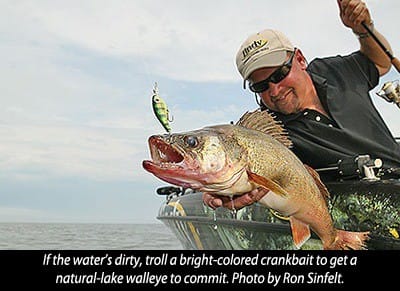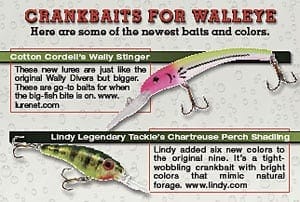By John Geiger, Game & Fish

Have you ever noticed that some guys consistently catch more walleyes than others? You might think it’s luck, but if you ask them, they’ll tell you that success is in the details. Water clarity, light penetration and lure color are all extremely important to successful walleye anglers. Here’s how to use these conditions to catch more fish in several different types of walleye waters.
OPEN-WATER TROLLING
Guide Jason Muche was trolling in about 25 feet of water. Walleyes in the 28- to 32-inch range were feasting on his offering of crawler harnesses with purple beads. The water was clear — you could see about 10 or 15 feet down. The fish were about 2-3 feet off the bottom. Even if the bite shut down right then, the guide’s angler would have gotten his money’s worth.
The sun got lower in the sky, and light was not penetrating the water as it had earlier. Muche realized it was time to change up his presentation.
“I took off the harnesses and changed to a crankbait with some rattle and tipped it with a crawler,” said Muche. “I also increased our trolling speed to 1-and-a-half mph. It worked like a charm.”
When the bite might have slacked off for other guys, Muche was able to keep the rods bent by changing up for a good reason.
Predator fish use three senses to find their food: seeing, smelling and picking up vibration mostly through their lateral line.
Earlier in the day, the fish had been relying mostly on sight to find and home in on prey. But now that the light was fading, vibrations and scent were becoming the more important factors, while the importance of the fish seeing the bait was fading with the light of day.
Muche tied on Lindy Shadlings, one in perch colors another in purple smelt. With the crankbaits, he was able to cover more water and still give the right presentation.
“Light is an important factor in trolling,” said Muche. “If you stay aware of the way it is changing around you and how it penetrates the water you’re fishing in, you’ll stay on top of your game.”
CRANKIN’ NATURAL LAKES
Some anglers think that walleye fishing is all about finesse. But these game fish are hunters. They have big, sharp teeth, and they are more than willing to chase a bait if they can see it or feel it.
“One of my favorite ways to fish for walleyes in natural lakes is with spinners trolled 1 foot above the fish,” said Jon Thelen a professional walleye angler with Lindy Legendary Tackle. “Sometimes, if I can’t get them to commit, I’ll go back over and pull lures a foot higher to entice them to bite.”
The idea is, if that bait is a little farther away, that predator fish won’t be able to get as good a look at it. The fish will still see the flash and feel vibration, but it will be more curious. You’ll have a better chance to get him to commit if he’s not exactly sure what it is. Your hookup ratio will improve.
The depth you start fishing a natural lake all depends on light penetration.

Move your boat over structure — like edges of flats and submerged points — and check it out with your graph. Figure out the depth the fish are holding. Now, what’s your light situation? How deep is the light going? How turbid is the water?
Thelen has a simple yet effective way to gauge penetration and turbidity in natural lakes.
“When I stop the boat, I stand on the back and look down for the stainless steel prop,” he said. “If I can see it clearly, that’s clean water. If it’s visible but it’s glimmering, then I call it moderate. If I can’t see it, that’s dirty water.”
With cleaner water and higher penetration, Thelen will fish his Lindy spinners and Shadling crankbaits 5 feet above fish. In moderate water and medium penetration, think 2-3 feet above the holding fish. In dirty water with low penetration, the lures will be just a foot above the fish. Tight action to say the least!
Similar to depth, Thelen changes lure colors depending on turbidity and penetration.
Clear water means natural colors, like shiner colors, and whatever the color of the forage base at your lake. In dirty water, match the forage base, but break out the brighter versions. Lindy’s Shadling comes in a Natural Perch and Shiner, but here’s where you’d tie on a Chartreuse Perch or Pink Dace Shadling. Similar to trolling-depth strategy, the fish might get spooked by chartreuse trolled by their noses on a bright day. But a few feet away, that same bait gets seen and doesn’t look unnatural — until after the fish commits and is hooked!
“If you know what they are eating, then match it. Then, base color selection on water clarity and light penetration,” said Thelen. “You’ll catch fish all day long.”
CLEAR-LAKE COLORS
Thelen’s theory works great on natural lakes with dirtier water. But what about the gin-clear lakes you might be fishing?
Guide Mike Christensen fishes big, extremely clear lakes. Visibility might be 8 or 12 feet deep. With water that clear, Christensen doesn’t go to a brighter-colored jig when there is less light penetration, but actually switches to a darker color to keep it natural.
The lesson hit home for Christensen a few years ago. He was fishing with Thelen in two tournaments a week apart. In the first, there was a weak bite that shut down as clouds rolled in. One of the anglers switched to a darker-colored jig and started catching big walleyes. Then they both tied on darker colors and brought their standing from near the bottom to fourth place in just a few minutes.
The next week, the same thing happened, but they were better prepared. The team made their way to second place before the bite slacked again.
“In a tournament, you might have a window of opportunity of only 15 or 20 minutes to get your fish that day,” said Christensen. “If you’re not ready to capitalize on it, you’ll miss it. Always pay attention to what’s going on around you and the color of your bait.”
This article was contributed by Game & Fish, a publication of Intermedia Outdoors. Visit www.gameandfishmag.com for more useful articles.
Other articles you might like:
Best New Fishing Products on Display







